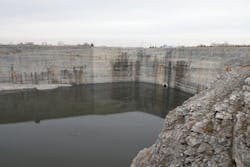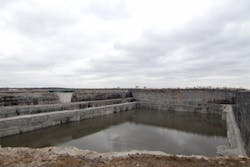Thornton Composite Reservoir fills for first time over Thanksgiving
Beginning on Thanksgiving, Nov. 26, the Metropolitan Water Reclamation District of Greater Chicago's (MWRD's) Thornton Composite Reservoir began to fill for the first time. It reached 17' and contained 400 million gallons of combined sewer overflow prior to being transported by tunnel for treatment at the Calumet Water Reclamation Plant.
The reservoir, located in the south suburbs near South Holland just north of the Tri-State Tollway (I-294), will benefit 556,000 people in 14 communities, including the South Side of Chicago and south suburbs. It will protect 182,000 homes, businesses and other facilities and improve water quality in the Calumet Rivers and Calumet-Sag Channel by collecting combined sewer overflows before entering waterways. The new reservoir holds these overflows before pumping the water 5.5 miles back to the Calumet Water Reclamation Plant for treatment.
Major construction connecting the reservoir to the tunnel was complete in September. Following gate installation, testing and waiting for rain, the complete reservoir system is online and can take in up to 7.9 billion gallons of water.
"We are happy to put our latest engineering marvel to work. The Thornton Composite Reservoir is the world's largest reservoir and has drawn intrigue from across the world," said MWRD President Mariyana Spyropoulos. "We thank our predecessors with the Board of Commissioners who had the foresight in 1972 to adopt a plan that made flooding and water quality genuine issues to prioritize. In past years, that polluted, untreated water would enter our waterways or worse, our basements. Because of TARP, combined sewer overflows have been drastically reduced, and the addition of Thornton will again lead to more water quality improvements upstream."
The 1,300 foot tunnel meets up with the existing, operational deep tunnels. After installing the gates, crews had to remove a 10-foot thick concrete mass separating the live tunnel from the reservoir. At 1,000 feet into the tunnel, the tunnel size transitions from 30 feet in diameter and splits into two massive tunnels that each house two thick wheel gates that can withstand 300 feet of water pressure and isolate the tunnels from the reservoir when necessary. Each of the four gates weighs approximately 100 tons.
A concrete apron constructed in front of the tunnel is designed to withstand the force of the water coming out of the tunnel, which can be at velocities of up to 30 feet per second, preventing erosion of the stone reservoir floor. Solar-powered aerators were installed in the reservoir and will float up and down with the water elevation, keeping the surface layer of water from going septic and causing odors.
About the Metropolitan Water Reclamation District of Greater Chicago
Established in 1889, the MWRD (www.mwrd.org) is an award-winning, special purpose government agency responsible for wastewater treatment and stormwater management in Cook County, Illinois.
The new reservoir holds these overflows before pumping the water 5.5 miles back to the Calumet Water Reclamation Plant for treatment. Communities that will benefit include Blue Island, Burnham, Calumet City, Calumet Park, South side of Chicago, Dixmoor, Dolton, Harvey, Lansing, Markham, Phoenix, Posen, Riverdale and South Holland.

